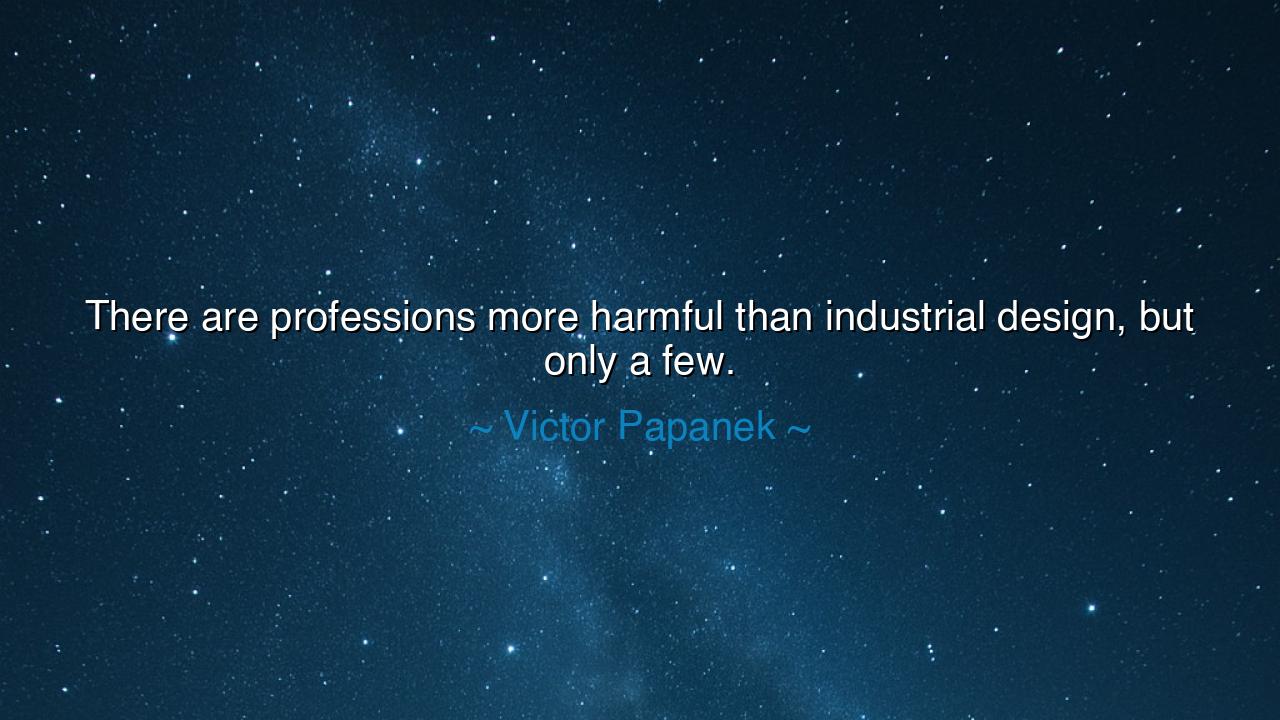
There are professions more harmful than industrial design, but






When Victor Papanek, the philosopher and prophet of sustainable design, wrote, “There are professions more harmful than industrial design, but only a few,” he struck a blow not against beauty, but against blindness — the blindness of creation without conscience. His words are not sarcasm, but sorrow. For Papanek saw how the noble art of design, born to serve human need, had become a servant of greed — crafting not tools for living, but trinkets of vanity. His warning was not to condemn designers, but to awaken them, to remind all who shape the world that to design is to wield power over lives, and that power without responsibility is among the most destructive forces on earth.
The origin of this quote lies in his 1971 book Design for the Real World, a work that shook the foundations of modern design thinking. In that era of industrial abundance, when advertising and aesthetics reigned supreme, Papanek dared to speak of ethics. Factories poured out mountains of disposable goods — sleek, fashionable, and soon forgotten — while half the world lived without clean water or shelter. “There are professions more harmful,” he said, perhaps thinking of arms merchants or propagandists, “but only a few.” For though the designer does not drop bombs or poison rivers directly, his creations — multiplied by millions — can choke the planet, clutter minds, and erode the spirit. In his view, the greatest danger was not malice, but indifference disguised as progress.
Papanek understood that design is not neutral. Every object carries intention: it serves or exploits, heals or harms. The designer who ignores the true needs of humanity is like a doctor who delights in disease. He told of cars that killed, toys that maimed, packaging that wasted, architecture that alienated — all designed with care, all created with pride, all detached from compassion. To him, the designer’s first duty was not to the market, but to the human condition. To design responsibly was to listen, to create for the poor as well as the privileged, for the future as well as the present. Anything less, he warned, was to contribute to the slow death of the planet.
Consider, for example, the tale of the plastic bottle. Once hailed as a miracle of convenience, it became one of the symbols of our collective negligence. Designed for comfort, it has now outlived its purpose, choking seas and suffocating wildlife. A single careless act of design multiplied across decades became a monument to waste. Yet the same mind that invented the bottle could have invented a better way — one rooted in renewal, not ruin. This is Papanek’s lament: that too often, we create without foresight, seeking elegance before ethics. The beauty of an object cannot outweigh the ugliness of its consequence.
And yet, his words were not meant to sow despair. In the heart of his criticism burned a hopeful fire — that design could become once more a force for good. He called for what he named social design — the creation of tools and systems that elevate life rather than exploit it. A designer who works for the blind, the aged, the forgotten, he said, does not merely create; he redeems. True design, in his vision, is an act of compassion made tangible — thought turned toward service. He believed that if designers reawakened their conscience, they could help heal the very world they had helped to wound.
Thus, this quote stands as a mirror and a moral test. It asks each creator, each innovator, each hand that shapes the material world: What is the consequence of your work? Do your creations serve the few or the many? Do they endure, or do they pollute? Do they uplift, or do they deceive? Papanek’s wisdom reminds us that the worth of any profession — whether of art, science, or industry — lies not in its brilliance, but in its benevolence.
So, O maker of things, take heed of this teaching. Do not design for applause, but for life. Let your work be guided not by trends, but by truth. Ask not only what can be made, but what should be made. Let every creation you bring into the world lighten the burden of another. For design, when guided by conscience, becomes sacred craft; but design without ethics, as Papanek warned, is among the most harmful of professions — beautiful in form, yet empty in soul.
And remember this final lesson: to create is to shape destiny. Every choice — every line, every material, every purpose — ripples outward into the vastness of time. Therefore, design as if the world depends on it. Because, as Victor Papanek knew, it does.






AAdministratorAdministrator
Welcome, honored guests. Please leave a comment, we will respond soon